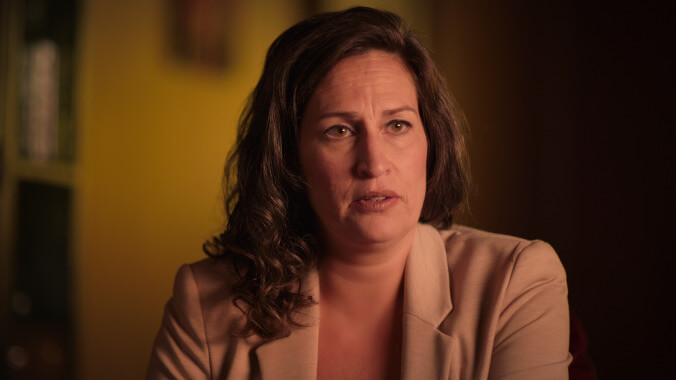Crime Scene: The Times Square Killer loses steam by overly dramatizing a dark case
Netflix’s true-crime docuseries hides important stories behind sensationalized statements in its second season

New York City’s blindingly bright neighborhood of Times Square gets extra attention during New Year’s Eve for its ball drop. Just in time for the big countdown, Netflix’s Crime Scene returns to examine the famed area through a dark and devastating lens. Directed by Joe Berlinger, the true-crime docuseries remains sensationalized in its second season as it examines Times Square’s sordid past. It feels only occasionally salient despite the grueling subject matter.
Crime Scene: The Times Square Killer probes how a freewheeling Times Square in the ’70s and ’80s became the breeding ground for a perverse Richard Cottingham, a.k.a. the Torso Killer, whose crimes include sexually assaulting and killing at least 11 sex workers. The show tackles his case by charting the rise of Times Square’s porn industry, illicit sex trafficking business, and a lack of police support for sex workers.
Undoubtedly, all of these factors played a role in Cottingham’s killing spree. Times Square as the world knows it now–a tourist trap full of LED billboards, Broadway musicals, plenty of stores, the prominent Ball Drop—was wholly different five decades ago. Crime Scene is at times a fascinating study of that era when peep show booths, X-rated shops, and sex clubs dominated a few unruly blocks of Midtown Manhattan.
But the series quickly loses its momentum by swinging unevenly between the crime scene and the serial killer. First, it hypes up Times Square with frequently used descriptors—“sex carnival,” “offered what you couldn’t find anywhere else,” “fulfills fantasies in different ways”—all used in dramatic fashion by the interviewees. Cottingham’s case opens the gateway to discuss how the neighborhood was basically hell on earth in the ’70s. While this may be true, overstated discussions of the same pull from any seriousness it holds.
To make it even worse, the excessive reenactments of a fictional Cottingham driving away with unsuspecting victims and trapping them in hotel rooms, or slow-motion footage of women walking down the city streets is jarring and unnecessary. If they’re meant to stir the imagination or set the scene, they do a shoddy job. These moments offer nothing besides manufactured drama.
Crime Scene then pivots to being a more traditional true-crime docuseries. It zooms a bit out of its setting because as it turns out, most of Cottingham’s crimes were actually committed in New Jersey from 1967 to 1980 before he was arrested. He was given the moniker of Torso Killer or Times Square Killer because the bodies of two of his victims, Deedeh Gooderzi and Jane Doe, were found without their heads or hands in a burning room at a Times Square hotel.
Through interviews with retired detectives, former sex workers, Cottingham’s co-worker from Blue Cross Blue Shield (where he worked as a computer operator), and a relative of one of his victims, Crime Scene then pieces together his brutal kills, and the difficult hunt to catch him, in no particular order. Committed fans of the genre will probably be able to stick through the theatrics and remain invested in the details of the case, even as they emerge haphazardly.
But Berlinger bites off more than he can chew with Crime Scene: The Times Square Killer. He only hints at deeper stories he could’ve explored within the three episodes. One of the show’s emotional and pivotal offerings comes through Jennifer Weiss, the biological daughter of Deedeh Gooderzi, who talks about wanting to find her birth mother only to learn of her cruel, untimely death. Crime Scene unfortunately and barely resolves her interesting arc in the last few minutes, looking at how it led her to contact Cottingham in prison.
In its first season, The Vanishing At The Cecil Hotel, Crime Scene failed to offer a nuanced take on mental health, which was central to the disappearance and death of Elisa Lam. In its second season, the show similarly attempts but fails to look at the negative impact on sex workers due to Times Square turning into an open porn district—the women couldn’t even turn to cops because their profession was illegal, so their lives (or deaths) seemed to have no worth. It’s an important, sensitive topic that deserves to be handled appropriately and effectively, but Crime Scene reflects on it sparsely.
The focus is on Times Square propelling Cottingham into his sinful acts, but the show doesn’t provide any other information about his upbringing, marital life, work, or literally anything else except for how his visits to the area allowed him to run amok. Without the necessary context, it feels like the show is blaming only Times Square for his psyche.
Crime Scene is meant to be about the titular topic, sure, but the idea falls flat if Cottingham’s location of crimes varies from town to town in a whole other state. By leaving essential details out in favor of vexing levels of directional flair, Crime Scene: The Times Square Killer misses the mark.